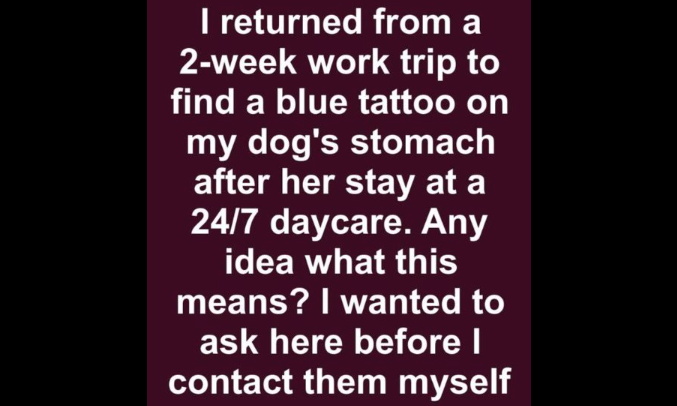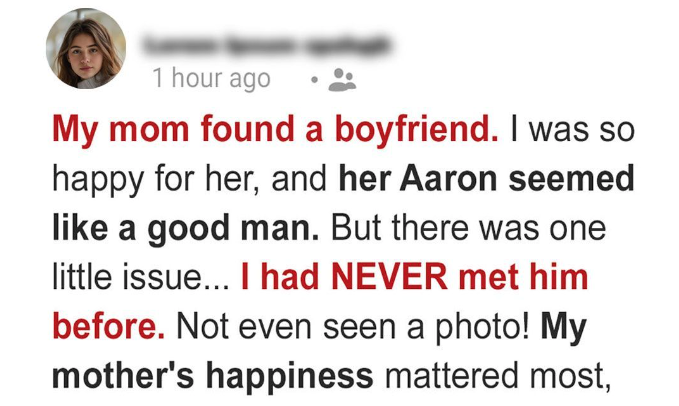After a two-week work trip, I returned home to find an unexpected blue tattoo on my dog Zuni’s belly, noticed during her time at a round-the-clock pet care facility. Curious and concerned, I shared the discovery in a local pet lovers’ online community, hoping to gather insights before contacting the daycare directly.
I included a photo in my post, showing Zuni, my pit-lab mix, resting on her side, displaying a faint blue mark near her abdomen. The mark appeared as a simple, single-line design—perhaps a digit or a letter—and I was certain it wasn’t there when I left her at the facility.
I took several moments to inspect the mark carefully before capturing the image.
I had been away at a professional training event in Vancouver, navigating two weeks of workshops, evening meals, and travel fatigue. I longed for Zuni’s company and had selected a “premium” 24/7 dog daycare named WagMore Acres, known for its live cameras, regular updates, and vibrant social media showcasing joyful dogs.
The drop-off process was seamless, with staff who seemed friendly and attentive. When I retrieved Zuni, she appeared content—maybe a little weary, but her tail wagged happily, and she nestled against me before dozing off during the drive home. It wasn’t until later that evening, during a routine belly rub, that I spotted the blue mark.
Within an hour of posting online, replies poured in.
Community members proposed it could be a spay tattoo, often used to show a dog has been neutered, avoiding redundant procedures. Some mentioned shelters frequently apply such markings. This seemed reasonable, but Zuni was already spayed when I adopted her two years prior.
And I knew for certain no tattoo was present then.
That evening, I sent an email to WagMore Acres and made a follow-up call the next morning. A staff member named Carly picked up, her tone initially warm, but it shifted when I brought up the tattoo.
She hesitated.
Then she said, “Let me speak with our shift supervisor. May I call you back?”
I agreed.
An hour went by. Then three more.
By noon, I called again, but no one answered.
A growing sense of concern took hold.
I decided to visit the daycare in person. It was a quick fifteen-minute drive from my house, situated behind a strip mall with a yoga studio and a vape shop. The building was recognizable—bright murals of playful cartoon dogs, synthetic turf, and a sign declaring, “WagMore: Where Dogs Are Family!”
At the reception, a new staff member didn’t know me.
When I asked for Carly, she said Carly was no longer employed there.
“She left last week,” the employee said, glancing nervously over her shoulder. “It was unexpected.”
I requested to speak with the owner or manager. After a brief pause, the employee slipped into the back.
I waited nearly ten minutes.
A tall, pale man with a clipboard appeared, introduced himself as Jeff, and offered a tense smile.
I described Zuni’s situation, showed him the photo, and stressed that she was already spayed before her stay. He leaned forward, examined the image, and said calmly, “That’s a spay tattoo. It’s typical. Some veterinarians add them later.”
“But she was already spayed,” I repeated.
He shrugged. “It could have been a precaution. We collaborate with local vet clinics if there’s any ambiguity.”
“Ambiguity about what?” I asked firmly. “You had no permission to perform any medical procedures.”
His tone shifted. He became reserved, speaking vaguely about “standard practices” and “miscommunications.” He referenced a general waiver I had signed, which included a clause about necessary veterinary care.
I insisted on knowing the name of the clinic they worked with. He said he’d need to “review the system” and promised to email me the information.
I left without replying.
No email arrived.
That night, sleep was difficult. Questions raced through my mind—what else had happened to Zuni? She seemed fine, but what if the daycare was concealing something?
The next morning, I took Zuni to our trusted veterinarian, Dr. Nguyen, who had cared for her since adoption. I showed him the tattoo, and he furrowed his brow before placing Zuni on the exam table.
He examined the mark closely.
“This is recent,” he said. “And poorly done.”
I asked if it was a spay tattoo.
“It’s made to look like one,” he said thoughtfully. “But it’s not in the typical location, and the ink is uneven. It appears amateurish.”
My stomach dropped.
He inspected Zuni’s spay scar, confirming it was unchanged and no new surgery had taken place.
“So they tattooed her,” I said. “To make it look like she was spayed?”
“Or to obscure something else,” he replied.
I felt ill.
Dr. Nguyen recommended bloodwork to check for other concerns. I agreed.
The results were mostly normal, but one detail stood out.
Zuni’s microchip data had been modified.
The chip still worked, but it now listed a new owner: Rachel Nevin.
I stared at the name on the report, hoping it was an error.
I had never heard of Rachel Nevin.
Dr. Nguyen retrieved Zuni’s original microchip records, registered under my name and address. He explained that someone must have submitted falsified documents to the chip registry to alter the ownership.
The pieces started to align.
The tattoo. The altered microchip. Carly’s abrupt exit. Jeff’s evasive answers.
Someone at WagMore had tried to claim Zuni as their own.
I contacted the microchip company immediately. After confirming my identity as the original owner, they froze the chip and flagged it for fraud. I asked how the information had been changed.
The representative explained, “Someone sent scanned forms—photo ID, vet records, the usual requirements.”
I requested copies of the documents.
They agreed, but only with legal authorization.
I reached out to my friend Junie, who works at a law firm. Though not a pet law specialist, she prepared a formal request on my behalf.
Three days later, I received a ZIP folder with the documents.
Opening them sent a shiver down my spine.
The photo ID was blurry but listed the name Rachel Nevin, with an address in nearby Riverside. The vet records were mostly fabricated, though some seemed scanned from Zuni’s actual file, indicating someone at WagMore had access to her records.
On one form, I saw Carly’s signature in the corner.
She hadn’t quit—she was either dismissed or left after attempting to steal my dog.
I updated the online pet community with this information. Within an hour, a woman named Luisa sent me a private message. She recognized the name Rachel Nevin—her friend’s dog had disappeared after a stay at WagMore two months earlier.
I asked for more details. Luisa called me.
Her voice trembled as she spoke.
“My friend Marta had a golden retriever named Miso. She left him at WagMore before visiting family in Mexico. When she returned, they said he escaped during an outdoor break—claimed he slipped his collar. But Marta always checked his harness, and he was microchipped.”
“What happened next?” I asked.
“They refunded her and sent a sympathy card. But she never found Miso. No shelter or vet had any record of him.”
I asked if Miso had a spay or neuter tattoo.
Luisa confirmed it was blue, on his belly.
Sleep evaded me that night.
Driven by determination and caffeine, I began researching. I explored property records, online reviews, and professional profiles. Carly had been WagMore’s “intake coordinator” and previously volunteered at a shelter that shut down due to animal mismanagement.
I also learned that WagMore wasn’t owned by Jeff but by an LLC linked to a man named Marcus Liddell. Further research uncovered disturbing civil suits—lost dogs, poor record-keeping, and one case settled privately for an undisclosed amount.
The next day, I reported everything to animal control.
They took my complaint seriously, particularly the microchip tampering, and launched an investigation.
Over the next two weeks, more pet owners came forward, sharing accounts of odd behavior, unexplained injuries, and missing dogs. One owner had records showing her dog was neutered twice, based on conflicting documents.
Within a month, WagMore was closed.
A local news outlet published a story titled “A Betrayal of Trust at a Beloved Daycare.” It was dramatic but fitting.
Carly faced no formal charges due to insufficient evidence, but the investigation revealed she had been re-homing dogs to friends or contacts, claiming they were strays or abandoned. Marcus, the owner, was fined for negligence and prohibited from operating pet-related businesses in the state.
Jeff, meanwhile, vanished—likely onto his next venture.
Then, two months later, I received a handwritten letter from Riverside.
It was from Rachel Nevin, the name listed as Zuni’s false owner.
She wrote:
“I didn’t know Zuni was stolen. Carly told me she was surrendered by a family unable to keep her, and she provided adoption papers. I only had Zuni for four days before the microchip company flagged it as fraud. I’m deeply sorry for what happened.”
She included her phone number, offering to talk.
At first, I wasn’t interested.
But a week later, curiosity prevailed.
I called Rachel. She was gentle and remorseful. She had lost her own dog to cancer and was eager to adopt again. Carly had described Zuni as a dog needing a calm home after being passed between owners.
“She was the sweetest dog I’ve ever met,” Rachel said, her voice breaking. “But I know she belongs to you.”
I paused.
Then I asked, “Was she okay with you?”
Rachel gave a small laugh. “More than okay. She slept on my feet and followed me everywhere.”
That night, I held Zuni a little closer.
Initially, I was consumed by anger and distrust, hesitant to rely on anyone. But now, nearly a year later, watching Zuni rest on the couch, I feel a sense of clarity.
Perhaps Zuni’s experience helped expose a larger issue.
And perhaps, for four days, she brought comfort to someone in mourning.
Cherish your pets. Stay attentive. Trust your instincts.
Even the most inviting places may not always be safe.
Please like and share to support those who can’t advocate for themselves. 🐾




